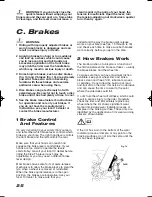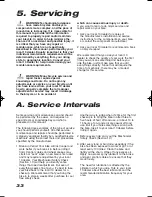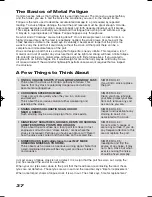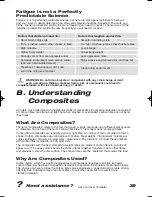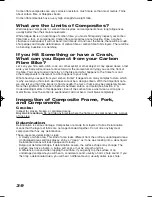
The Basics of Metal Fatigue
Common sense tells us that nothing that is used lasts forever. The more you use something,
and the harder you use it, and the worse the conditions you use it in, the shorter its life.
Fatigue is the term used to describe accumulated damage to a part caused by repeated
loading. To cause fatigue damage, the load the part receives must be great enough. A crude,
often-used example is bending a paper clip back and forth (repeated loading) until it breaks.
This simple definition will help you understand that fatigue has nothing to do with time or age.
A bicycle in a garage does not fatigue. Fatigue happens only through use.
So what kind of “damage” are we talking about? On a microscopic level, a crack forms in a
highly stressed area. As the load is repeatedly applied, the crack grows. At some point the
crack becomes visible to the naked eye. Eventually it becomes so large that the part is too
weak to carry the load that it could carry without the crack. At that point there can be a
complete and immediate failure of the part.
One can design a part that is so strong that fatigue life is nearly infinite. This requires a lot of
material and a lot of weight. Any structure that must be light and strong will have a finite fatigue
life. Aircraft, racing cars, motorcycles all have parts with finite fatigue lives. If you wanted a
bicycle with an infinite fatigue life, it would weigh far more than any bicycle sold today. So we
all make a tradeoff: the wonderful, lightweight performance we want requires that we inspect
the structure.
A Few Things to Think About
In most cases a fatigue crack is not a defect. It is a sign that the part has worn out; a sign the
part has reached the end of its useful life.
When your car tyres wear down to the point that the tread bars are contacting the road, those
tyres are not defective. Those tyres are worn out and the tread bar says “time for replacement.”
When a metal part shows a fatigue crack, it is worn out. The crack says “time for replacement.”
37
• ONCE A CRACKS STARTS IT CAN GROW AND GROW FAST.
Think about the crack as forming a pathway to failure. This
means that any crack is potentially dangerous and will only
become more dangerous.
• CORROSION SPEEDS DAMAGE.
Cracks grow more quickly when they are in a corrosive
environment.
Think about the corrosive solution further weakening and
extending the crack.
• STAINS AND DISCOLORATION CAN OCCUR
NEAR A CRACK.
Such staining may be a warning sign that a crack exists.
• SIGNIFICANT SCRATCHES, GOUGES, DENTS OR SCORING
CREATE STARTING POINTS FOR CRACKS.
Think about the cut surface as a focal point for stress (in fact
engineers call such areas “stress raisers,” areas where the
stress is increased). Perhaps you have seen glass cut? Recall
how the glass was scored and then broke on the scored line.
• SOME CRACKS (particularly larger ones) MAY MAKE
CREAKING NOISES AS YOU RIDE.
Think about such a noise as a serious warning signal. Note that
a well-maintained bicycle will be very quiet and free of creaks
and squeaks.
SIMPLE RULE 1:
If you find a crack, replace
the part.
SIMPLE RULE 2:
Clean your bike, lubricate
your bike, protect your bike
from salt, remove any salt
as soon as you can.
SIMPLE RULE 3:
Inspect and investigate any
staining to see if it is
associated with a crack.
SIMPLE RULE 4:
Do not scratch, gouge or
score any surface. If you do,
pay frequent attention to this
area or replace the part.
SIMPLE RULE 5:
Investigate and find the
source of any noise. It may
not a be a crack, but what-
ever is causing the noise
should be fixed promptly.
13
owners manual GENERIC A5 aw
05/05/14
10:25 Page 39



